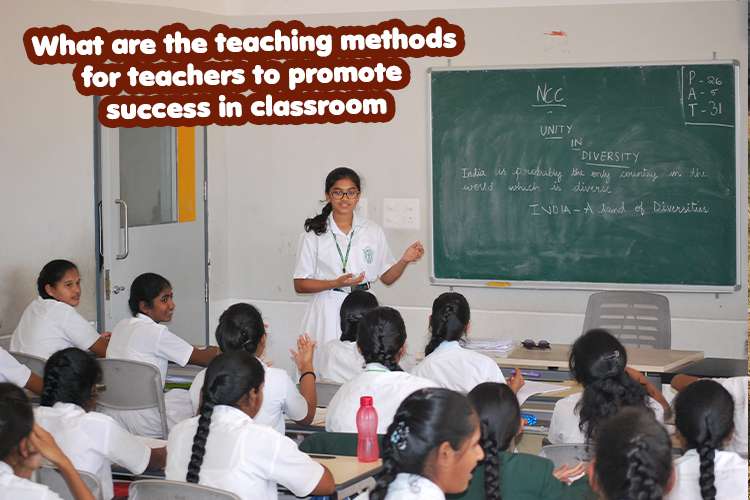Education is the key to unlocking a brighter future for students, and effective teaching methods play a crucial role in empowering them for success. Teachers have the power to shape young minds, inspire curiosity, and cultivate a love for cognitive knowledge. However, not all teaching methods are equally effective in engaging pupils and fostering their academic growth. Discovering the best ways to enhance children’s future.
As educators, teachers play a very vital role in shaping the minds of the schoolers and preparing them for life’s success. Effective teaching methods not only facilitate cognitive knowledge but also inspire and empower educators to reach their full potential.
How to implement effective teaching methods?
Ignite the potential of pupils with innovative teaching methods in classrooms. In the ever-evolving landscape of education, implementing effective teaching methods is key to fostering success in the classroom.
From student-centered approaches to technology integration empower school childrens, foster a love for Intellectual development, and create an inclusive environment. Get ready to revolutionise education and inspire lifelong achievement. Some strategies and techniques that empower teachers to unlock the pupils’ potential and promote academic growth are mentioned below.
1. Foster student-centre intellectual development –
By shifting the focus from a teacher-centric approach to student-centered Intellectual development, educators can create an inclusive and engaging classroom environment. Encourage active participation, peer collaboration, and student-led discussions to cultivate critical thinking and problem-solving skills. By giving school learners more autonomy, teachers empower them to take charge of their own intellectual development journey.
2. Using technological integration –
Recognise technology as a potent instrument to improve intellectual development environments. Make classes more interactive and immersive by incorporating educational applications, internet resources, and interactive media. Technology creates new opportunities for involvement and makes it possible for students to have individualised intellectual development experiences, from virtual field excursions to gamified exams.
3. Differentiating instructions –
Recognise that pupils have diverse intellectual development styles and abilities. Implement differentiated instruction by providing varied pathways to learning. Tailor your teaching methods to accommodate individual needs, offering alternative assignments, flexible grouping, and personalised support to ensure every student can thrive academically.
4. Encouraging critical thinking and problem solving –
Equip disciples with critical thinking and problem-solving skills that will serve them beyond the classroom. Incorporate open-ended questions, real-world scenarios, and hands-on activities to stimulate analytical thinking and encourage disciples to develop innovative solutions.
What teaching strategies work best for student learning?
When it comes to student learning, certain teaching strategies have proven to be highly effective in promoting engagement, comprehension, and long-term retention. Prepare to revolutionise your teaching and elevate student learning to new heights of achievement and success.
Discover the innovative strategies that empower educators to create dynamic, student-centered environment as given below:
1. Cooperative cognitive knowledge –
Promote collaboration and teamwork through cooperative cognitive knowledge strategies. Assign group projects, discussions, and debates that encourage disciples to exchange ideas, develop empathy, and enhance their communication skills. By fostering a sense of shared responsibility, attendees learn to value diverse perspectives and work towards common goals.
2. Inquiry-based techniques –
Such strategies pique attendees’ interest and create love for learning. Encouraging kids to ask questions, investigate subjects on their own, and look for solutions via research are main goals of this inquiry technique. This approach encourages critical thinking, the development of research skills, and active knowledge gathering.
3. Project-based trainings –
Immerse attendees in authentic, real-world projects that require them to apply knowledge and skills across disciplines. By working on hands-on projects,pupils develop creativity, problem-solving abilities, and a deeper understanding of subject matter. Projects can be individual or collaborative, fostering a sense of ownership and pride in their work.
4. Flipped classroom –
Incorporate the flipped classroom model, where children learn new concepts at home through pre-recorded lectures or readings and then engage in application and discussion-based activities in class. This approach allows for more interactive and personalised classroom sessions, where teachers can provide individualised support and address specific needs.
When and where to apply teaching methods?
Teaching methods play a crucial role in fostering effective experiences and maximizing student engagement. Educators must carefully consider when and where to apply specific teaching methods to ensure optimal outcomes. Explore the importance of context and timing in selecting appropriate instructional approaches, highlighting the significance of adapting teaching methods to diverse informative environments and individual student needs which includes:
1. Subject-specific applications –
Each subject may require a tailored approach. For instance, project-based knowledge acquisition can be particularly effective in science and social studies, where students can conduct experiments or explore historical events. Cooperative knowledge delivery is to be implemented in language arts and foreign language classes to enhance communication skills and cultural understanding.
2. Grade-level considerations –
Teaching methods should be adjusted to suit the developmental stage of students. Younger children may benefit from hands-on activities and games, while older educates may engage more effectively through technology integration and project-based cognitive knowledge. Flexibility is key to meet the needs of diverse age groups.
3. Cultural relevance –
Consider the cultural background and diversity within your classroom. Incorporate culturally relevant teaching materials, diverse perspectives, and inclusive content. By creating an inclusive and culturally sensitive environment, you foster a sense of belonging and respect among scholars.
As educators, it is our responsibility to adapt and evolve with the ever-changing needs of our scholars. By implementing innovative teaching methods, we can create classrooms that inspire success, foster critical thinking, and cultivate a love for lifelong cognitive knowledge. Whether it’s embracing technology, promoting collaboration, or tailoring instruction, these approaches empower teachers to unlock the potential within each student, ensuring they are equipped with the skills necessary to thrive in the 21st century and beyond. Let us embrace these strategies and embark on a transformative educational journey that prepares our scholars for a bright future.




